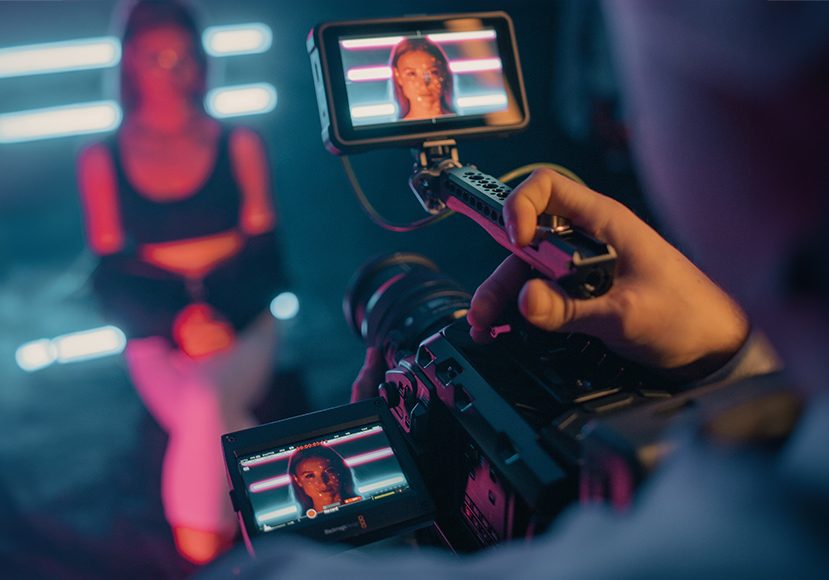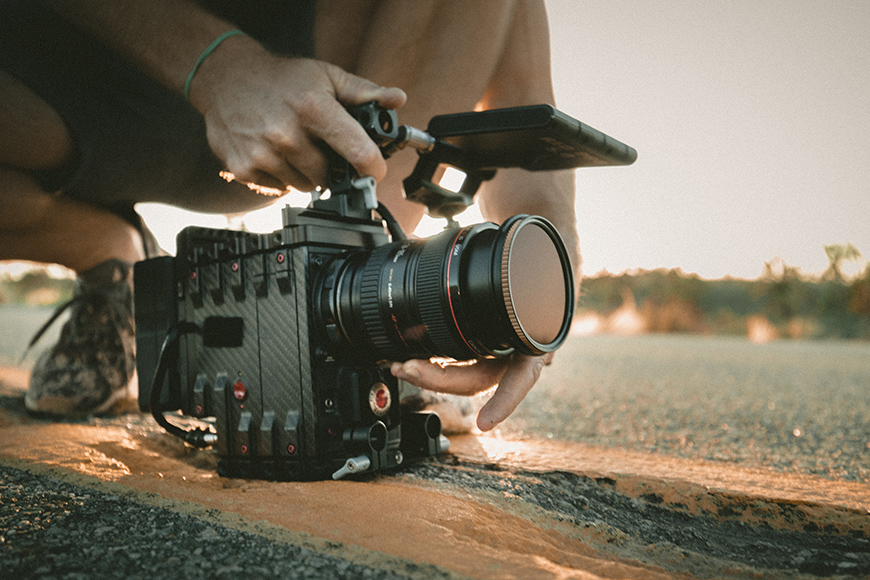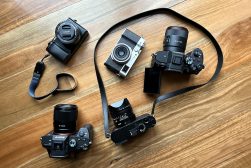
How to Choose the Best Frame Rate for Your Videos
Learn how video frame rate affects the quality, style, and compatibility of your videos and the best video frame rates to use for different projects.
Knowing how to choose the best frame rate for your videos opens up a range of new filmmaking techniques.
Different frame rates can be used to create smoother footage as well as effects such as slow motion.
It’s an effective way to add dramatic tension in narrative filmmaking or showcase action with heightened clarity.
Read on, and I’ll break down the various frame rates you can use and the best applications for video content creation.
I’ll also cover the optimal frame rates for popular online platforms such as Instagram Reels, YouTube, and TikTok.
Table of Contents
What Is Frame Rate?
A frame rate represents the number of frames per second recorded by your camera and is expressed as frames per second (fps).
There are a variety of frame rates available for video content creators, each of which has its own specific applications.
For example, if you choose a frame rate of 24fps, 24 individual frames each second are captured in just one continuous recording.
Here’s a breakdown of all the frame rates for video and the qualities and contexts in which these frame rates are used.
Which Frame Rate Is Best For Video?
| Frame Rate | Best Uses |
|---|---|
| 24 fps | – Film production (cinematic look) |
| – High-quality video content | |
| – Dramatic or artistic storytelling | |
| 30 fps | – Standard video content |
| – Television broadcasts | |
| – News reporting | |
| – Vlogging and casual filming | |
| 60 fps | – Smooth motion in fast-paced scenes |
| – Video games and gaming content | |
| – Action sports and high-motion activities | |
| – Slow-motion effects (when slowed down to 24 or 30 fps) | |
| 120 fps | – High-quality slow-motion effects |
| – Action-packed scenes with crisp motion | |
| – Sports analysis and replay | |
| – Scientific research and analysis (e.g., biomechanics) | |
| 240 fps | – Ultra-slow-motion effects |
| – Scientific research requiring extremely detailed analysis | |
| – Motion analysis in specialized fields | |
| 480+ fps | – Specialized scientific and industrial applications |
| – Extremely detailed motion analysis |
24 fps
The 24fps frame rate has been historically associated with movie production and remains the standard for films and some television shows to this day.
Recording at 24 frames per second creates footage that is the most natural looking for the human eye, with motion blur occurring when the shot moves swiftly.
This makes it the best frame rate for dramatic and storytelling content, such as short and feature films, or for documentary filmmaking.
30 fps:
Adding more frames to increase the frame rate to 30fps will increase the amount of information gathered so the video appears smooth.
This frame rate is commonly used for live TV and sports, with the extra frames capturing motion in finer detail where less motion blur occurs.
It’s also a common frame rate for some video games, as well as recording video for television shows such as soap operas.
While European television is often shot at 25fps, North American television productions typically use the faster frame rate of 30fps.
Streaming video and vlogging content for social media and video content platforms are also usually recorded at 30 frames per second.
60 fps
Doubling 30fps to 60 frames per second allows for the recording of much smoother video with twice the information recorded each second.
Some sporting and wildlife broadcasts use 60fps, as well as video games that are played on high-end computers capable of maintaining this rate.
It’s also sometimes used for some action movies and will typically result in a project of twice the file size compared to one shot at 30fps.
Shooting video in 60 frames per second also allows for the creation of slow-motion footage when the recording is slowed down and played back at 24fps or 30fps.
120 fps and higher
One of the most popular frame rates for creating a slow-motion shot is 120 frames per second, which delivers the effect when slowed down to give the slow-motion effect.
Slow motion shots can also be created by shooting at 240 frames per second to create even slower footage when played back at 24pfs or 30fps.
These very high frame rates are typically used sparingly in movies to enhance the atmosphere and tension of a particular scene or showcase action.
It’s also a frame rate for video that is often used in sporting events, such as replays of goals being scored in soccer to highlight the action.
If you record footage at high frame rates to achieve a slow-motion effect, bear in mind you’ll need appropriate software, such as Adobe Premiere, to slow the clip down.
The Best Shutter Speed for Different Frame Rates
Before you decide to experiment with shooting video footage using different frame rates, you need to be aware of how this interacts with shutter speed.
By understanding the relationship between frame rate vs shutter speed, you can ensure your camera is set up to record the action accurately.
Fortunately, the general rule of thumb to bear in mind is simple, with the 180-degree relation forming the golden rule of motion in videography.
This rule dictates that your shutter speed should be approximately double your frame rate in order to create natural-looking footage with pleasing motion blur.
For example, if you’re shooting video at 24fps, your shutter speed should be set to 1/50 second, while 60fps will need a shutter speed of 1/120 second.
Your shutter speed affects motion first and foremost, so bending the 180-degree rule can be used in some circumstances to create a unique effect on the recording.

Jakob Owens
A notable example in cinema of how the interaction between shutter speed and frame rate can be used for artistic results is Chungking Express.
In this movie, cinematographer Christopher Doyle shot at 14fps and used step printing to duplicate images twice and create the illusion of slow motion.
This creates the effect of enhanced blurring of the background elements while keeping the subject sharply defined within the frame.
This technique was used in Quentin Tarantino’s Reservoir Dogs, using the step printing process from footage shot at 24fps with triple the duplicated images.
The effect of this filmmaking technique is similar to slow motion, replicating each frame multiple times for a staggered effect when played back at the normal speed.
Best Frame Rates at a Glance
Best Frame Rate for Instagram Reels
Instagram Reels upload requirements recommend a minimum frame rate for video of 30 frames per second with a resolution of at least 720p
While some smartphones are capable of displaying higher video frame rates, 30 frames per second remains the optimal rate for Instagram Reels.
Best Frame Rate for YouTube
YouTube supports a variety of frame rates that content creators can use for their video-making activities.
While 24fps is the recommended frame rate for YouTube, 30fps is also commonly used on the platform.
Some content creators use more frames when creating content with lots of motion or recording gaming videos, such as 60fps.
Best Frame Rate for iPhone
The default frame rate setting for most iPhones is 30fps, and as such is the frame rate you’ll most often see for this format.
However, you can change the video frame rate to 60fps using an iPhone to introduce more frames for a crisper aesthetic.
There’s also the option to shoot in 24fps on iPhone to achieve a cinematic look, which was used for the Oscar-winning movie Tangerine.
For this movie, the director used the Filmic Pro app to allow for a 24fps video frame rate with high-quality compression rates.
Best Frame Rate for TikTok
TikTok content creators are advised to use either 30fps or 60fps when creating content for the platform.
Again, choosing the higher frame rate will result in smoother footage, although most TikTok users prefer to stick to 30fps.
This is usually accomplished using a picture resolution of 1080p, with the platform not offering support for 4K video at the time of writing.
Best Frame Rate for Slow Motion Video
There are two common video frame rates used for shooting slow-motion footage, with standard slow-motion typically shot at 60fps.
120fps can be used for slower motion, producing video footage that is approximately five times slower when played back at 24fps.
You can also shoot using a video frame rate of 240fps for even slower video when played back at a lower rate, although many cameras don’t support this frame rate.
Some specialist cameras offer much higher frame rates, for example, the Phantom HD Gold high-speed camera used by the Slow Mo Guys to achieve an extreme slow-motion shot.
This is capable of recording video at 2500fps at 1080p resolution, 5000fps at 720p, and an eye-watering 10000fps at 480p/
Best Frame Rate for Tutorials
Video tutorials are typically recorded at 24fps to achieve a naturalistic and relatable aesthetic for the audience can relate to.
With that said, 30fps is also common for tutorials and is commonly used for YouTube video tutorials by content creators.
The designated platform you plan on uploading the tutorial will ultimately dictate the frame rate you choose to use for your video.
Best Frame Rate for Gaming
30fps is the most common video frame rate used for gaming since most gaming PC setups are capable of handling this rate.
However, higher-specification gaming rigs are able to play games at 60fps to offer smoother and more responsive gameplay.
This is especially the case for fast-paced games such as first-person shooters and racing games, where a fraction of a second can make a huge difference in gameplay.
Best Frame Rate for 1080p Video
Both 30fps and 60fps are commonly used when recording 1080p video, and either can be used depending on the purposes of the video.
A 30fps video frame rate is typically used for online content creation to create a naturalistic look and pleasing to the eye motion blur.
60fps brings in more detail but can suffer from enhanced realism that makes props and other image elements appear “fake” and have a soap opera look.
Best Frame Rate for 4K Video
If you’re shooting video footage in 4K resolution, most cameras will allow you to set the frame rate at either 24pfs, 30fps, or 60fps.
60fps is the optimal frame rate setting when shooting fast-paced action such as sports and can be used for creating slow-motion footage
With that said, 30fps is commonplace for general video content creation, while 24fps brings additional blur to motion for a cinematic look.
Some cameras, such as the Canon EOS R5 and Sony A7S III, allow footage to be shot in 4K at 120fps for high-resolution slow-motion shots.
Relationship Between Shutter Speed and Frame Rate
Shutter Speed vs. Frame Rate
I’ve touched briefly on the Golden Rule, in which a camera’s shutter speed should be double the value of its frame rate.
This is known as shooting at the 180-degree shutter angle and is standard practice for videography and cinematography.
This ratio is what delivers smooth and realistic motion when played back with “normal” motion blurring.
With that said, there are exceptions to the rule, such as the opening sequence of Saving Private Ryan, which uses a higher frame rate for a staccato aesthetic.
Generally speaking, bending this rule will create a strange-looking effect that varies depending on how you alter the shutter speed beyond the conventional parameters.
Shutter Angle vs. Shutter Speed
A camera’s shutter angle is generally applied to rotary shutters in which the angled opening spins, allowing the light to enter once per revolution to expose each frame.
Most commonly used in motion picture cameras, the shutter angle is measured in degrees rather than fractions of a second as with shutter speed.
Depending on the angle of the shutter, it will have a different effect on how motion is captured, with a 180° shutter angle considered normal in filmmaking.
Using a tighter shutter constricts motion blurring, with a stuttering, stop-motion animation look as seen in the aforementioned Saving Private Ryan.
The Impact of Frame Rate on Viewer Experience
Depending on the frame rate you choose, the subsequent footage will have a different impact on the viewer.
Here’s a brief breakdown of these effects and their application in media.
Motion Perception
The baseline frame rate for motion portrayal stands at between 10 and 12 FPS, with anything lower perceived as individual images.
We’ve explored how 24 FPS is used for a cinematic look with pleasing blur in motion, while 30 FPS sharpens the viewer’s perception of motion.
Both 30 FPS and 60 FPS can result in what is known as the “soap opera effect,” which is caused by motion interpolation.
This is where extra frames are inserted between the original frames, resulting in footage that appears hyper-real and “fake.”
Emotional and Psychological Effects
The choice of frame rate can play a significant role in the mood, emotions, and psychological effects of a video.
Perhaps the most common usage of frame rates for emotional impact is the use of slow motion in movies.
This can be used to heighten tension and anticipation during action sequences and enhance dramatic moments.
Some filmmakers take things further by abandoning the FPS to shutter speed rule for more abstract or expressionistic filmmaking.
While these techniques should be used sparingly, when applied correctly, they can enhance the storytelling and create a more immersive scene.
Technical Considerations
Hardware and Frame Rate Capabilities
Different cameras have their own inherent maximum recording frame rates and corresponding resolutions.
For example, while many cameras can record at 24 FPS or 30 FPS in 4K, not all have the option to shoot 60 FPS or 120 FPS in full UHD.
Shooting at a higher FPS also uses up more storage space and creates a larger file size, which is something to bear in mind when choosing your FPS.
Editing and Post-Production
When editing video projects that use multiple frame rates across several clips, it’s possible to convert between frame rates.
Software such as Adobe Premiere, DaVinci Resolve, and free tools like VEED encode footage using an algorithm to create additional frames for a smooth output.
For slow-motion video, footage shot at 120 FPS or higher is played back at a standard speed, such as 24 FPS or 30 FPS, so the extra frames shot at 120 FPS deliver slow motion.
You can also use software to interpolate in-between images from footage to increase the refresh rate of your videos or simulate slow-motion effects.
How to Choose the Best Frame Rate for Video
Now that I’ve covered the core fundamentals and applications of frame rates let’s explore how to choose the best FPS for your project.
The first thing you should consider is what platform you intend to use to host the video since some platforms have limitations.
Next, you’ll want to consider the subject matter: if you’re shooting a short film, then 24 FPS makes sense, as this will give it a cinematic look.
If you’re a content creator on YouTube, 30 FPS is the most common, although gaming videos may work better at 60 FPS.
Sequences that call for heightened dramatic tension can be shot at 120 FPS, then played back at standard frame rates (24/30 FPS) for slow motion.
If you’re new to videography, it’s a good idea to play around with your camera’s frame rate settings and see how it looks for yourself.
Experimentation is a great way to discover new filmmaking tricks that you might otherwise not come across if you stick exclusively to one FPS rate.
FAQs on Frame Rate for Video
Does the frame rate affect the file size of a video?
The frame rate you opt to shoot your video in can have a significant impact on the file size. A video clip shot at 60fps has double the frames of one shot at 30fps, and this additional information takes up space.
Just as the capacity of the file increases, so too does the bandwidth required to play back the video clip smoothly, which also affects the final size of the video file.
Does the frame rate affect the quality of your video?
The principal impact your choice of frame rate will have on your video is related to the consistency of motion and the smoothness of the video.
It does not impact the quality of your video in terms of its resolution, although a higher frame rate’s smooth effect can make a video look less choppy.
How do you change a camera’s frame rate?
The specific setting varies between camera manufacturers and models for changing its frame rate, so you should refer to the instructions for your particular camera.
You should also be mindful that you may need to change the camera’s resolution in order for some frame rates to activate.
For instance, if you want to shoot footage at 120fps using the Sony A7iii camera, this isn’t possible while the resolution is set to 4K.
Is a higher frame rate better for video?
Increasing the frame rate of your video doesn’t necessarily make it better, although it will improve the smoothness of the footage in playback.
A higher frame rate also gives you a few additional options in post-production, for example, creating slow-motion videos for your scenes.
With that said, a higher rate of frames per second doesn’t improve the overall clarity and image quality of the recorded video, which is affected by picture resolution.
Should I shoot video in 30fps or 60fps?
The frame rate you choose will depend on the nature of the footage you’re shooting and where you’re planning on sharing it online.
For most videographers and content creators, shooting at 30fps is the optimal frame rate for the bulk of the content they create.
Alternatively, if you’re shooting fast motion or are introducing slow-motion shots in your video making, shooting at a frame rate of 60fps is required.
Is 24 fps or 30 fps better for video?
While most digital content creators will shoot at a video frame rate of 30fps, 24fps is the frame rate associated with traditional movie making.
As such, some filmmakers prefer to drop their frame rates down to 24fps to give the video quality a cinematic look.
This is because the 24fps frame rate for cinematic video introduces more motion blur compared to the crisper and cleaner image when shooting at 30fps video frame rates.














